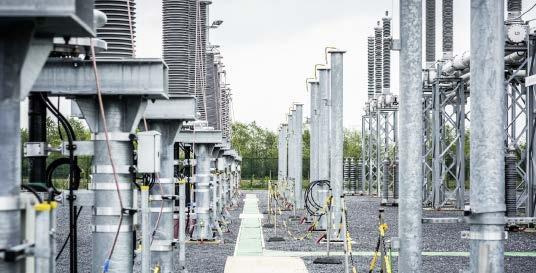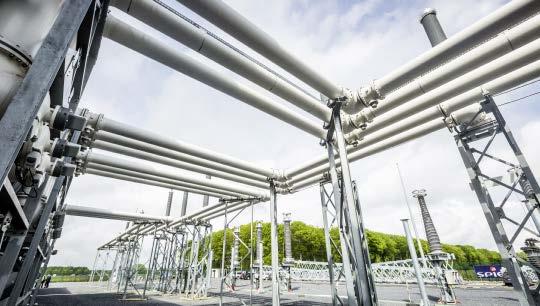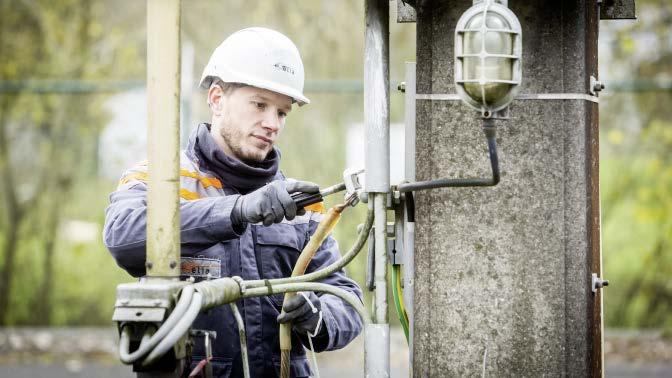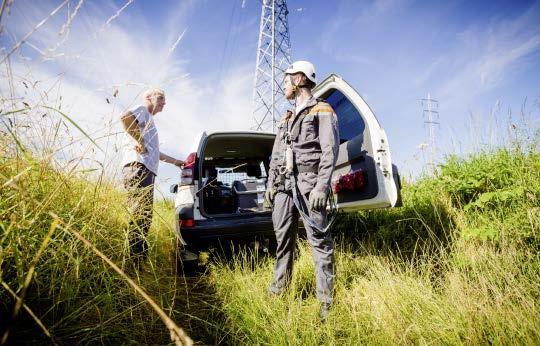
7 minute read
4.6. Additional interconnectors: economic results
Additional interconnections are a must to enable the necessary decarbonisation while keeping prices convergent with the neighbouring countries. Their realisation needs to be anticipated taking into account the often long construction delays. The favourable Cost-Benefit Analysis of additional interconnectors results from better market and renewables integration, without taking into account (in this study) the additional contribution to adequacy at critical peak moments.
This section deals with the results obtained through the cost benefit analyses performed for additional interconnectors in Belgium. As described in Section 2.7.3, an increase of Belgium’s cross-border exchanges capabilities was assessed for 2030 and 2040 as follows: — A North-South corridor adding 1 GW with NL and FR; — An East-West corridor adding 1 GW with DE and GB; — Both corridors at the same time. The interconnectors are assessed by considering the optimal thermal mix identified for each scenario as described in Section 4.4. The yearly average gain for the Belgian market welfare is compared to the annuity and fixed costs of the projects considered for each corridor. It identifies the benefits of additional cross-border exchanges with our neighbouring countries (on top of the already planned investments). It is important to note that this economic assessment is limited to Belgium and does not consider the economic results for the other countries. The market welfare results and annuities considered are the ones for Belgian society. The assessment does not quantify the benefit of additional interconnections for adequacy. Depending on the level of adequacy of the neighbouring countries, such benefits would increase the business case. However, they are not taken into account in this study. Figure 102 summarises the yearly net gain for Belgium (market welfare gain from which the annuities were deducted) generated by each additional corridor following all the scenarios considered in this study.
YEARLY GAIN FOR BELGIUM WHEN INVESTING IN + 2GW CORRIDORS IN M€/YEAR (FIG. 102)
BE additional corridors
2030 2040
+1 GW
+1 GW
+1 GW BC DEC RES BC DEC
C2G G2C C2G G2C C2G G2C C2G G2C C2G G2C C2G
-20 -20 -20 -10 ≈0 ≈0 40 60 130 40 110
20 ≈0 30 20 40 30 20 10 40 40 100
+1 GW
+1 GW +1 GW
+1 GW +1 GW
-10 -30 -20 -20 20 ≈0 50 60 150 50 190
RES Grid+ Flex+
G2C G2C G2C
130 40 30
110 80 20
210 100 50
From the results, it can be stated that additional interconnection capacity is a must do for Belgium from an economic point of view. With the increase of RES, additional interconnections are a ‘no regret’ option in the long-term and a benefit to Belgian society. The welfare increase in Belgium is mainly driven by lower wholesale electricity prices with additional interconnectors allowing Belgium to remain competitive with its neighbours. In 2040, the robustness of those investments was evaluated with two additional European sensitivities for 2040 (‘GRID+’ and ‘FLEX+’): — The results obtained through the ‘GRID+’ scenario assess the robustness of the economic results obtained in the 2040
‘Large Scale RES’ scenario by considering an additional 30 GW of interconnection capacity (added in both directions) between all European countries. The increased capacity on the different borders for ‘GRID+’ is described in Section 2.7.5; — In the ‘FLEX+’ scenario, the economic results obtained are relatively close to the gain obtained in the 2040 ‘Decentral’ scenario. For this time horizon, it can be stated that more demand flexibility has a limited impact on the positive economic trend identified for new Belgian corridors.
The favourable Cost-Benefit Analysis of additional interconnectors results from better market and renewables integration. Note that this result only assessed the benefit from additional corridors (no individual project) for Belgian society. Moreover, additional interconnection capacity will be necessary to achieve high decarbonisation rates while maintaining prices in line with our neighbouring countries by integrating more renewable generation. With the unfolding energy transition, their positive economic contribution will steadily increase: the faster the decarbonisation of the electricity system, the better the economics of interconnector development.
BOX 14 - ADDITIONAL INTERCONNECTIONS ARE NOT SIGNIFICANTLY IMPACTING THE REVENUES OF BELGIAN GAS UNITS
Additional interconnections in 2030 and 2040 will not significantly impact the revenues of an efficient Belgian thermal fleet. The result in CCGT revenues for each scenario with and without interconnectors can be seen in Figure 103. It results that the additional interconnectors (+4 GW) with Belgium have no significant impact on efficient CCGT revenues. This finding can be explained by the fact that gas-fired generation will set the price in the wholesale market in
IMPACT ON EFFICIENT CCGT REVENUES BY ADDING 4 GW OF INTERCONNECTORS IN BELGIUM (FIG. 103)
CCGT revenues in [€/kW] 100 90 80 70 60 50 40 30 20 10 0
2030 - C2G
BC DEC RES
CCGT revenues in [€/kW] 100 90 80 70 60 50 40 30 20 10 0
2030 - G2C
BC DEC RES
Western Europe (see also Section 4.8.1) most of the time. Additional interconnectors will enable more energy to be imported when prices are lower or equal to the marginal cost of efficient CCGTs. On the other hand, when prices are higher than the marginal cost of a CCGT (hence CCGTs inframarginal rent is positive), the same level of price is observed in the neighbouring countries which leads to a similar amount of revenues inboth cases. Figure 104 illustrates those results for a given ‘Monte-Carlo’ year in the ‘Base Case’ scenario for 2030.
ADDITIONAL INTERCONNECTIONS DO NOT SIGNIFICANTLY IMPACT THE REVENUES FOR GAS FIRED UNITS - HOURLY MARGINAL PRICE FOR BELGIUM IN THE 'BASE CASE - C2G' SCENARIO IN 2030 FOR A GIVEN ‘MONTE-CARLO’ YEAR (FIG. 104)
250
[Marginal price [€/MWh] 200
150
100
50
1
2
3
0
0 1000 2000 3000 4000 5000 6000 7000 8000 Without additionnal corridor With additionnal EW+NS corridors
1 Hours when there is an inframarginal rent for CCGT. Additional interconnectors will not significantly impact the revenues as those are moments when the prices in the neighbouring countries are also higher than the CCGT marginal price (low penetration of RES) or at the same level.
2 CCGTs are marginal. The flat curve shows that the efficiency of the unit will be key to determine its position in the merit order. While the most efficient units in the system would run around 5000 hours in this specific case , the units with a slightly lower efficiency will only run 1000 hours a year. When CCGTs are marginal, no or very low inframarginal rent is captured by those units as the price is set by the same technology. 3 Moments with high penetration of renewables in the neighbouring countries will impact the prices in Belgium when adding additional interconnectors. Given that those moments are not in the first zone (when CCGTs are making revenues), it will only impact the prices below or equal to CCGTs being marginal thus not affecting their revenues.
BOX 15 - SEVERAL STUDIES HAVE DEMONSTRATED THE NEED FOR FURTHER INTERCONNECTIONS ACROSS EUROPE TO ENABLE THE ENERGY TRANSITION
The need for additional interconnection capacity is not only a key enabler for the Belgian energy transition. Several recent studies, from academia, authorities, industrial and non-governmental bodies confirm the growing international consensus that significant transmission developments are urgently needed to underpin the energy transition in the most cost-efficient way. Not only do interconnections limit the curtailment of excess renewable energy, they also enhance the possibility of reaching the EU renewable targets by incentisizing renewable investments in the most suitable areas: wind in the North, especially in offshore and large coastal areas, solar in the South, biomass where local sources are available and hydro in the North and in mountain areas.
“Investments in transmission and distribution grids for integrating VRE are a small portion of the total investments in the power sector” “This analysis demonstrates the potential for regional smoothing through interconnection, illustrating the changing role of transmission grids under high shares of VRE” “Grids can expand the potential of variable renewables and increase their value”
IEA – ‘World Energy Outlook 2016’ [IEA-3] “Grids decrease the need for flexibility: fluctuations in generation (wind and PV) and demand are equilibrated alarge distances.” “Grids enable access to cost-effective flexibility options in Germany and Europe.” “Transmission grids reduce overall system costs with relatively small investment costs.” ‘12 Insights on Germany’s Energiewende’ – Agora Energiewende [AGO-1]
“Several European analyses highlight the strategic geographic situation of Belgium. From a European perspective, the optimal solution requires an increase in transmission capacity in Belgium to allow for electricity transfers between European states. Belgium would therefore become an electricity transmission hub within Europe.” ‘Scenarios for a low carbon Belgium by 2050’ - Federal Climate Change Service commissioned a study by CLIMACT and VITO [CLV-1]
“We observe that a sufficiently large transmission system is worth more than it costs for higher penetrations of renewables, as they reduce the total system cost due to reduced backup capacity and energy.” ‘Cost-optimal design of a simplified, highly renewable pan-European electricity system’ Rolando A. Rodriguez, Sarah Becker b, Martin Greiner, [SCD-1]
“Upgrading the grid infrastructure is, however, the most cost–effective way to keep a power system in transition secure and reliable. Less transmission build-out will lead to less optimal use of RES and additional need for back-up capacity ” ‘Power Perspectives 2030’ – European Climate Foundation [ECL-1] “The network extension rate is driven by the increase of generation capacities, especially renewable energy sources”.
‘e-Highway 2050’ study [EHW-1]







